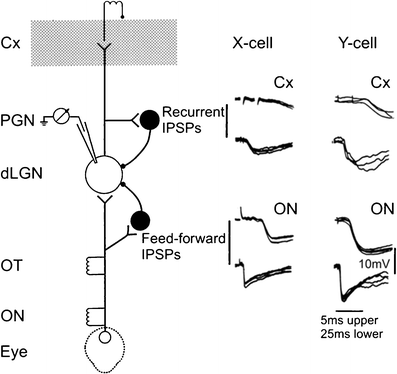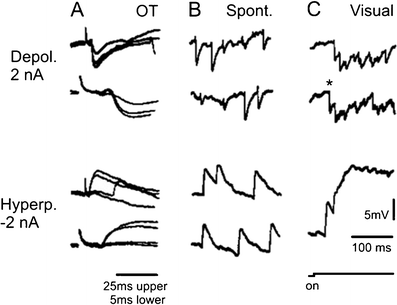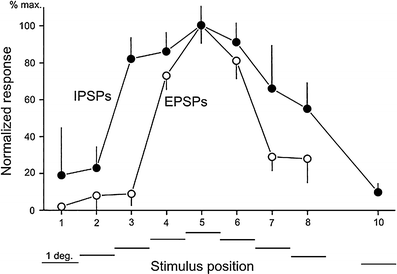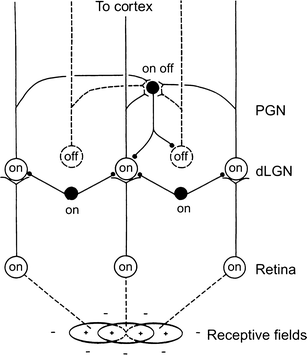Feedforward and recurrent inhibitory receptive fields of principal cells in the cat's dorsal lateral geniculate nucleus
- PMID: 21127903
- PMCID: PMC3023014
- DOI: 10.1007/s00424-010-0900-7
Feedforward and recurrent inhibitory receptive fields of principal cells in the cat's dorsal lateral geniculate nucleus
Abstract
Principal cells in the dorsal lateral geniculate nucleus receive both feedforward and recurrent inhibition. Despite many years of study, the receptive field structure of these inhibitory mechanisms has not been determined. Here, we have used intracellular recordings in vivo to differentiate between the two types of inhibition and map their respective receptive fields. The feedforward inhibition of a principal cell originates from the same type of retinal ganglion cells as its excitation, while the recurrent inhibition is provided by both on- and off-centre cells. Both inhibitory effects are strongest at the centre of the excitatory receptive field. The diameter of the feedforward inhibitory field is two times larger, and the recurrent two to four times larger than the excitatory field centre. The inhibitory circuitry is similar for X and Y principal cells.
Figures











Similar articles
-
Refinement of Spatial Receptive Fields in the Developing Mouse Lateral Geniculate Nucleus Is Coordinated with Excitatory and Inhibitory Remodeling.J Neurosci. 2018 May 9;38(19):4531-4542. doi: 10.1523/JNEUROSCI.2857-17.2018. Epub 2018 Apr 16. J Neurosci. 2018. PMID: 29661964 Free PMC article.
-
Two classes of single-input X-cells in cat lateral geniculate nucleus. II. Retinal inputs and the generation of receptive-field properties.J Neurophysiol. 1987 Feb;57(2):381-413. doi: 10.1152/jn.1987.57.2.381. J Neurophysiol. 1987. PMID: 3559685
-
Effects of brain stem parabrachial activation on receptive field properties of cells in the cat's lateral geniculate nucleus.J Neurophysiol. 1995 Jun;73(6):2428-47. doi: 10.1152/jn.1995.73.6.2428. J Neurophysiol. 1995. PMID: 7666150
-
Comparison of receptive-field properties of X and Y ganglion cells with X and Y lateral geniculate cells in the cat.J Neurophysiol. 1979 Jan;42(1 Pt 1):274-91. doi: 10.1152/jn.1979.42.1.274. J Neurophysiol. 1979. PMID: 219159
-
Spatial frequency analysis in the visual system.Annu Rev Neurosci. 1985;8:547-83. doi: 10.1146/annurev.ne.08.030185.002555. Annu Rev Neurosci. 1985. PMID: 3920946 Review. No abstract available.
Cited by
-
Reciprocal inhibition and slow calcium decay in perigeniculate interneurons explain changes of spontaneous firing of thalamic cells caused by cortical inactivation.J Comput Neurosci. 2013 Jun;34(3):461-76. doi: 10.1007/s10827-012-0430-8. Epub 2012 Nov 13. J Comput Neurosci. 2013. PMID: 23150147 Free PMC article.
-
From Receptive to Perceptive Fields: Size-Dependent Asymmetries in Both Negative Afterimages and Subcortical On and Off Post-Stimulus Responses.J Neurosci. 2021 Sep 15;41(37):7813-7830. doi: 10.1523/JNEUROSCI.0300-21.2021. Epub 2021 Jul 29. J Neurosci. 2021. PMID: 34326144 Free PMC article.
-
Synaptic mechanisms of temporal diversity in the lateral geniculate nucleus of the thalamus.J Neurosci. 2013 Jan 30;33(5):1887-96. doi: 10.1523/JNEUROSCI.4046-12.2013. J Neurosci. 2013. PMID: 23365228 Free PMC article.
-
T-type calcium channels promote predictive homeostasis of input-output relations in thalamocortical neurons of lateral geniculate nucleus.Front Comput Neurosci. 2014 Aug 28;8:98. doi: 10.3389/fncom.2014.00098. eCollection 2014. Front Comput Neurosci. 2014. PMID: 25221503 Free PMC article.
References
Publication types
MeSH terms
LinkOut - more resources
Full Text Sources
Miscellaneous

